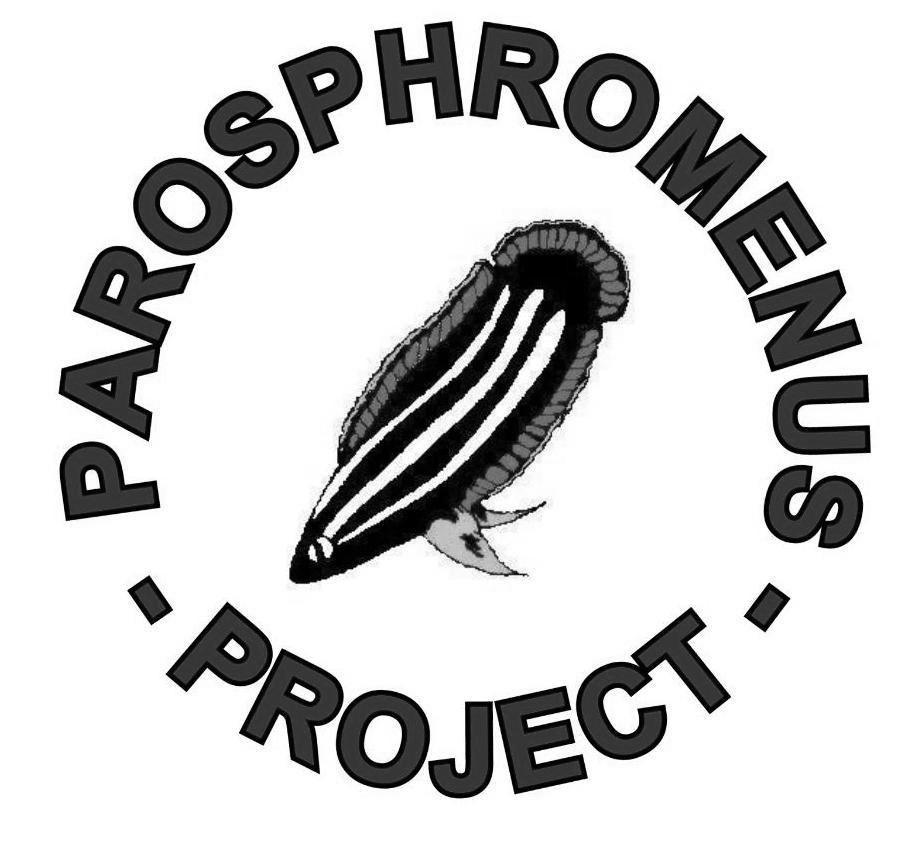Paro-Newsletter No. 107  Bielefeld, January 28th, 2013
Bielefeld, January 28th, 2013
Dear friends, we begin the third full year of Parosphromenus project after it has become global. Here again are some messages, and refer you most to the points 2 (English-language booklet with descriptions and many photos of our Licorice Guramies), 3 (corrections to the last Census, with special reference to P. sumatranus) and 4 (all species back in stock). We are very pleased that we have for the first time all 20 scientifically described species in our stock (point 3).
1. We welcome new members to the project
Again, there are new members to the Parosphromenus-project:
– Mariam Al Bala’a from West Malaysia – Maciej Chochla from Gliwice (Poland) – Jordy van Grevenbroek from Holland
We are happy that there is not just a wide geographic distribution of our members, but also the fact that in addition to beginners in Paro-aquaristics very competent and experienced people come to us, too. This is remarkable because in most countries the availability of Licorice Gouramies is very limited and mostly confined to the pet store, and they offer them rarely, usually incorrectly declared and, unfortunately, often in poor health. All new members a warm welcome!
2. Booklet on Licorice Gouramies published in English language
Thanks to David Armitage (AAGB), a well-equipped 48-page booklet in English with all species descriptions by Peter Finke and many photos of the fish and their habitats is now available; all texts taken from our website. This is the first volume of a planned series of special publications of the British journal ‘Labyrinth’. The edition is rather limited; best order not too late!
For one copy please transfer 4.00 + 3.00 (package and postage) = 7.00 GBP (British pounds) via Paypal to the account of AAGB. Go to the Paypal homepage and enter the address cjlabyrinth@tiscali.co.uk for the AAGB. Paypal also offers a conversion to other currencies. Please announce your order in addition to the address westowfish@yahoo.co.uk because from there the booklets will be shipped. If you want to order more than one copy, please ask at this address if there are special conditions for it.
3. Further corrections to the last census, and remarks concerning P.sumatranus
Boris Weber Schwartz pointed out that alleged P. sumatranus attributed to his stock factually are a bintan-form and must be classified under cf. bintan. Thus the stock of sumatranus is still smaller. P. Finke, however, was able to receive some young P. sumatranus from M. Kloster (Berlin) and C. Hinz equally has taken over parts of Kloster’s population; there is offspring already. – We have to correct a remark from a previous newsletter that there apparently are two types at sumatranus, those with a higher body and head down courting and those very slim bodied with head above courting. Although the two body types exist, the remark on different courting was obviously an observation error, which had been communicated to us this way. All sumatranus court similarly to ornaticauda and parvulus,
that is with the head upwards! It is still unclear whether the two body types exist disjoint or if there are two poles between which there are all intermediate forms also.
4. Goodnews: All species are back in stock
We can report as latest good news: All 20 species scientifically described are back in the livestock of the Parosphromenus-project. Additionally, several undescribed forms are available. In Germany the livestock is fully present, in other countries only partially.
This means that even the longtime nonexistent species allani is back, as well as the hitherto undescribed spec. Sungai Stunggang or the new form spec. Ampah. Only the latter is due to the trade. We especially welcome the return of the first two named, which are the only species/forms we know from Sarawak. In addition, there is a bad information, too: One of the two known localities of allani is completely destroyed by now. Instead of a healthy black water river there is now a rice field to be found, and no more Licorice could live there any longer (information: C. Hinz).
I one distinguishes three categories only – good, average or poor stock – then the picture is mixed, but overall nearly satisfactory. We have a few species / forms with good stock that cause no worries (such as the nagyi variants, linkei, quindecim or spec. Sentang); then many species / forms in the middle class, with either low breeding success or a distribution to a few breeders only; and every failure could minimize or endanger the entire stock (eg. anjunganensis, sumatranus, opallios, rubrimontis or spec. Dua). Third the category with poor stock encompasses all species / forms that are present only in very small stocks or with a single breeder or even without any offspring so far, so that there is the constant danger of total loss (deissneri, allani, gunawani (former spec. Danau Rasau) paludicola forms except Paka, spec. Sungai Stunggang).
In summary: Do not slack off in breeding the species in particular in the last two categories! However, we have the return of allani and spec. Sungai Stunggang, and we hope that this time it might be possible to increase both small stocks to spread and thus be maintained in the long run. Moreover, the situation for sumatranus has improved.
5. 2012 Report on the Advisory Board
The Steering Group has sent its annual report to the Advisory Board in early January, which this time relates to the development of the project in 2012. Meanwhile it is published on the homepage.
6. Get well soon!
Our webmaster Helene Schoubye has broken one leg at the turn of the years. We wish her well soon!
Until the next newsletter, warm regards from your steering group. Responsible: Peter Finke (Bielefeld / Germany).
(We are always open to suggestions for improving the newsletter. French version was created with the help of machine translation. Apologize therefore the linguistic errors).

